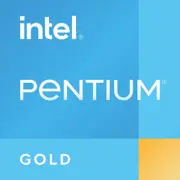Intel Pentium Gold 4415Y

Intel Pentium Gold 4415Y: Compact Energy Efficiency for Basic Tasks
April 2025
Introduction
The Intel Pentium Gold 4415Y processor, released in 2017, is still found in budget laptops and ultra-portable devices. Despite its outdated architecture, it remains relevant for certain use cases. In this article, we will explore who might benefit from such a CPU in 2025 and what compromises need to be considered.
Architecture and Process Technology: Modest Capabilities
Cores, Threads, and Clock Speeds
The Pentium Gold 4415Y is built on the Kaby Lake architecture (14 nm) and falls into the category of ultra-budget low-power processors. Its main specifications are:
- 2 cores and 4 threads thanks to Hyper-Threading.
- Base frequency: 1.6 GHz. There’s no Turbo mode—this is a fixed frequency even under load.
- Cache: 2 MB L3.
Integrated Graphics
The built-in GPU is the Intel HD Graphics 615 with 24 execution units (EUs) and a frequency of up to 850 MHz. This is a modest graphics accelerator capable of handling 4K video (with hardware decoding) but not designed for modern gaming.
Power Consumption and TDP: Focus on Battery Life
The CPU's TDP is 6 W, allowing it to be used in devices without active cooling (such as tablets or ultra-thin laptops). This is a key advantage for formats where the following are important:
- Silent operation.
- Minimal thickness.
- Long battery life.
However, the low TDP limits performance—the CPU cannot maintain high frequencies for long due to the lack of thermal headroom.
Performance: Realistic Expectations
Office Tasks and Multimedia
- Office applications (Word, Excel, browser with 5-10 tabs): The processor handles it, but experiences delays when multiple programs run simultaneously.
- Video playback: 4K/60 FPS on YouTube or local files (thanks to VP9 and HEVC decoders).
- Photo editing software: Basic retouching in Lightroom or Photoshop is possible, but rendering will take longer.
Gaming
The HD Graphics 615 is suitable for casual projects:
- Minecraft (30-40 FPS on low settings).
- CS:GO (720p, low detail, ~25-30 FPS).
- Modern AAA games (like Cyberpunk 2077) — won't run.
Turbo Mode: Lack of Dynamic Overclocking
The absence of Turbo Boost is a significant drawback. Even under load, the frequency remains at 1.6 GHz, which limits performance in resource-intensive tasks.
Use Cases: Who is the 4415Y Designed For
1. Students — for working with text documents, presentations, and online courses.
2. Office workers — email, documents, video conferencing.
3. Portable device users — compact convertible laptops (for example, Microsoft Surface Go with similar CPUs).
4. Backup devices — as a secondary laptop for travel.
Not suitable for:
- Video editing.
- 3D modeling.
- Modern gaming.
Battery Life: Up to 10 Hours Under Ideal Conditions
Thanks to the 6 W TDP, laptops with the Pentium Gold 4415Y demonstrate battery life of 8-10 hours under moderate load (screen brightness at 50%, Wi-Fi, office tasks). Contributing factors include:
- SpeedStep technology — dynamic frequency reduction during idle times.
- Low power mode in Windows/Linux.
However, battery life heavily depends on the capacity of the battery. For example:
- A laptop with a 38 Wh battery (ASUS VivoBook) — up to 7 hours.
- A device with a 50 Wh battery (Lenovo IdeaPad) — up to 10 hours.
Comparison with Competitors: Competing in the Budget Segment
AMD Athlon Silver 3050e (2020)
- 2 cores/2 threads, Vega 3 GPU.
- 6 W TDP, but graphics performance is 15-20% stronger.
- Better for gaming but worse for multi-threaded tasks.
Apple M1 (2020)
Not a direct competitor, but by 2025, even used MacBook Air with M1 ($400-500) will outperform the Pentium Gold in all parameters, including battery life.
Intel Celeron N4500 (2021)
- 2 cores/2 threads, 6 W TDP.
- Lags in multi-threading due to the absence of Hyper-Threading.
Conclusion: The Pentium Gold 4415Y in 2025 is only relevant in devices priced up to $350. With a budget of $400 or more, it makes more sense to choose laptops based on Intel Alder Lake-N (e.g., N100) or AMD Ryzen 3 7320U.
Pros and Cons
Strengths
- Low power consumption and noiselessness.
- Support for 4K video.
- Affordable device prices ($300-450).
Weaknesses
- Low performance in multitasking.
- Outdated 14 nm process technology.
- Absence of Turbo Boost.
Recommendations for Laptop Selection
1. Device type: Ultrabook or convertible (for example, HP Pavilion x360).
2. Minimum specifications:
- 8 GB RAM (4 GB in 2025 will be painful).
- 256 GB SSD (not HDD!).
- IPS screen with 1920x1080 resolution.
3. Optimal models:
- Lenovo IdeaPad 3 15IGL05 ($330) — 15.6", 8/256 GB.
- ASUS Laptop 14 F415MA ($299) — 14", 4/128 GB (requires an upgrade).
Avoid:
- Laptops with 1366x768 screens.
- Configurations with 4 GB of RAM.
Final Conclusion: Who is the Pentium Gold 4415Y Suitable For
This processor is a choice for those who:
1. Are looking for a cheap laptop for basic tasks.
2. Value battery life and portability.
3. Do not plan to run demanding applications.
Key Benefits:
- Low device cost.
- Ability to work all day without recharging.
- Sufficient performance for web surfing and office tasks.
Alternative for 2025: If the budget allows adding $100-150, consider laptops based on Intel N100 or AMD Ryzen 3 7320U — they offer better performance and modern technologies (Wi-Fi 6, USB-C with Power Delivery).
Basic
CPU Specifications
Memory Specifications
GPU Specifications
Miscellaneous
Share in social media
Or Link To Us
<a href="https://cputronic.com/en/cpu/intel-pentium-gold-4415y" target="_blank">Intel Pentium Gold 4415Y</a>